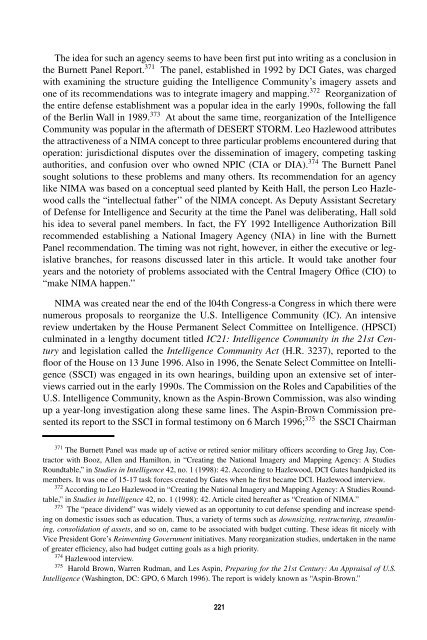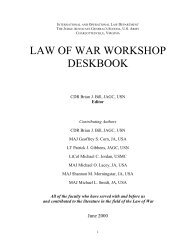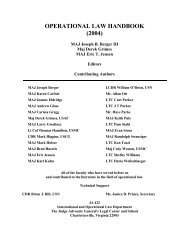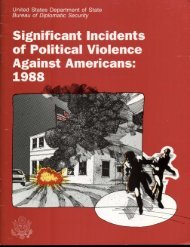learning with professionals - Higgins Counterterrorism Research ...
learning with professionals - Higgins Counterterrorism Research ...
learning with professionals - Higgins Counterterrorism Research ...
Create successful ePaper yourself
Turn your PDF publications into a flip-book with our unique Google optimized e-Paper software.
The idea for such an agency seems to have been first put into writing as a conclusion in<br />
the Burnett Panel Report. 371 The panel, established in 1992 by DCI Gates, was charged<br />
<strong>with</strong> examining the structure guiding the Intelligence Community’s imagery assets and<br />
one of its recommendations was to integrate imagery and mapping. 372 Reorganization of<br />
the entire defense establishment was a popular idea in the early 1990s, following the fall<br />
of the Berlin Wall in 1989. 373 At about the same time, reorganization of the Intelligence<br />
Community was popular in the aftermath of DESERT STORM. Leo Hazlewood attributes<br />
the attractiveness of a NIMA concept to three particular problems encountered during that<br />
operation: jurisdictional disputes over the dissemination of imagery, competing tasking<br />
authorities, and confusion over who owned NPIC (CIA or DIA). 374 The Burnett Panel<br />
sought solutions to these problems and many others. Its recommendation for an agency<br />
like NIMA was based on a conceptual seed planted by Keith Hall, the person Leo Hazlewood<br />
calls the “intellectual father’’ of the NIMA concept. As Deputy Assistant Secretary<br />
of Defense for Intelligence and Security at the time the Panel was deliberating, Hall sold<br />
his idea to several panel members. In fact, the FY 1992 Intelligence Authorization Bill<br />
recommended establishing a National Imagery Agency (NIA) in line <strong>with</strong> the Burnett<br />
Panel recommendation. The timing was not right, however, in either the executive or legislative<br />
branches, for reasons discussed later in this article. It would take another four<br />
years and the notoriety of problems associated <strong>with</strong> the Central Imagery Office (CIO) to<br />
“make NIMA happen.’’<br />
NIMA was created near the end of the l04th Congress-a Congress in which there were<br />
numerous proposals to reorganize the U.S. Intelligence Community (IC). An intensive<br />
review undertaken by the House Permanent Select Committee on Intelligence. (HPSCI)<br />
culminated in a lengthy document titled IC21: Intelligence Community in the 21st Century<br />
and legislation called the Intelligence Community Act (H.R. 3237), reported to the<br />
floor of the House on 13 June 1996. Also in 1996, the Senate Select Committee on Intelligence<br />
(SSCI) was engaged in its own hearings, building upon an extensive set of interviews<br />
carried out in the early 1990s. The Commission on the Roles and Capabilities of the<br />
U.S. Intelligence Community, known as the Aspin-Brown Commission, was also winding<br />
up a year-long investigation along these same lines. The Aspin-Brown Commission presented<br />
its report to the SSCI in formal testimony on 6 March 1996; 375 the SSCI Chairman<br />
371 The Burnett Panel was made up of active or retired senior military officers according to Greg Jay, Contractor<br />
<strong>with</strong> Booz, Allen and Hamilton, in “Creating the National Imagery and Mapping Agency: A Studies<br />
Roundtable,” in Studies in Intelligence 42, no. 1 (1998): 42. According to Hazlewood, DCI Gates handpicked its<br />
members. It was one of 15-17 task forces created by Gates when he first became DCI. Hazlewood interview.<br />
372 According to Leo Hazlewood in “Creating the National Imagery and Mapping Agency: A Studies Roundtable,”<br />
in Studies in Intelligence 42, no. 1 (1998): 42. Article cited hereafter as “Creation of NIMA.”<br />
373 The “peace dividend” was widely viewed as an opportunity to cut defense spending and increase spending<br />
on domestic issues such as education. Thus, a variety of terms such as downsizing, restructuring, streamlining,<br />
consolidation of assets, and so on, came to be associated <strong>with</strong> budget cutting. These ideas fit nicely <strong>with</strong><br />
Vice President Gore’s Reinventing Government initiatives. Many reorganization studies, undertaken in the name<br />
of greater efficiency, also had budget cutting goals as a high priority.<br />
374 Hazlewood interview.<br />
375 Harold Brown, Warren Rudman, and Les Aspin, Preparing for the 21st Century: An Appraisal of U.S.<br />
Intelligence (Washington, DC: GPO, 6 March 1996). The report is widely known as “Aspin-Brown.”<br />
221

















